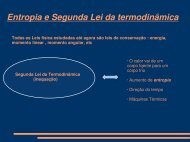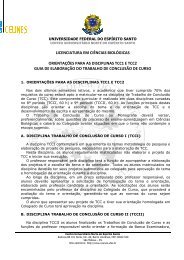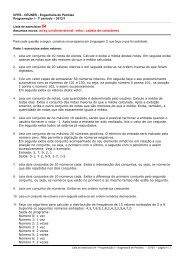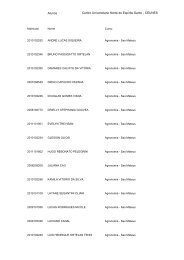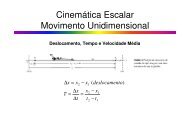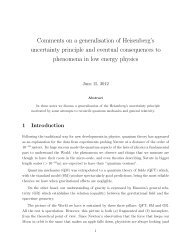ProgramaçËao Linear - Notas de aula - CEUNES
ProgramaçËao Linear - Notas de aula - CEUNES
ProgramaçËao Linear - Notas de aula - CEUNES
You also want an ePaper? Increase the reach of your titles
YUMPU automatically turns print PDFs into web optimized ePapers that Google loves.
CAPÍTULO 2. SISTEMAS LINEARES 13Teorema 2.6. Seja e uma operação elementar e E = e(I m ) a matriz elementar correspon<strong>de</strong>nte.Então para toda matriz A <strong>de</strong> or<strong>de</strong>m m × n temose(A) = EA.Demonstração. Deixamos a prova do resultado para as operações L i ↔ L j e L i → kL i para oleitor. Seja e a operação L i → L i + kL j (i ≠ j). Sem perda <strong>de</strong> generalida<strong>de</strong>, vamos supor quei = 1 e j = 2. Assim⎡⎤ ⎡1 k 0 · · · 00 1 0 · · · 0EA = ⎢⎥ ⎢⎣ . . . · · · . ⎦ ⎣0 0 0 · · · 1⎡= ⎢⎣⎤a 11 a 12 a 13 · · · a 1na 21 a 22 a 23 · · · a 2n⎥. . . · · · . ⎦a m1 a m2 a m3 · · · a mn⎤a 11 + ka 21 a 12 + ka 22 a 13 + ka 23 · · · a 1n + ka 2na 21 a 22 a 23 · · · a 2n⎥. . . · · · .a m1 a m2 a m3 · · · a mn⎦ = e(A).Ativida<strong>de</strong> 2. Complete a prova do teorema anterior.Em outras palavras, o Teorema 2.6 diz que aplicar uma operação elementar em A é o mesmoque multiplicar A a esquerda pela matriz elementar correspon<strong>de</strong>nte.Cada matriz elementar é inversível, e sua inversa é a matriz elementar correspon<strong>de</strong>nte àoperação que <strong>de</strong>sfaz a original:• a operação L i → 1L k i <strong>de</strong>sfaz a operação L i → kL i . Assim por exemplo, se E =[ ] 1 0então E −1 =(verifique este fato constatando que EE0 1/k−1 = I 2 ).[ 1 00 k• a[operação]L i → L j <strong>de</strong>sfaz a própria operação L i → L j . Assim por exemplo, se E =0 1então E1 0−1 = E (verifique!).• a operação[L] i → L i − kL j [<strong>de</strong>sfaz a]operação L i → L i + kL j . Assim por exemplo, se1 0E = então E2 1−1 1 0=(verifique!).−2 1Uma consequência imediata do Teorema 2.6 é a seguinte:Corolário 2.7. Sejam A e B matrizes <strong>de</strong> mesma or<strong>de</strong>m. Então B é linha equivalente a A se,e somente se B = E k E k−1 · · · E 2 E 1 A para certas matrizes elementares E 1 , . . . , E k .[ ] [ ]1 2 9 18Exemplo 2.1.5. Mostre que são linha equivalentes as matrizes A = e B = .3 6 6 12Vamos calcular a MLRFE <strong>de</strong> A:[ ] [ ][ ]1 2 L 2 →1/3L 2 1 2 LA = −−−−−−→2 →L 2 −L 1 1 2−−−−−−→ C = .3 61 20 0[ ] [ ]1 01 0Observe que, sendo E 1 =e E0 1/3 2 =as matrizes elementares correspon<strong>de</strong>ntesàs operações realizadas, temos−1 1C = E 2 E 1 A.]



